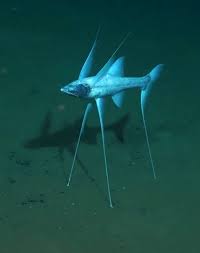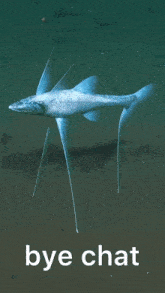
The tripodfish, sometimes referred to as the abyssal spiderfish, has long, bony rays that stick out below its tail fin and both pelvic fins.
The fish's head-and-body is up to 43.4 cm (17.1 in) long, but its fins can be more than 1 m (3 ft 3 in). Most of the time, the tripodfish stands on its three fins on the bottom of the ocean, hunting for food.
Even though the fins are presumably quite stiff, researchers have been successful in surprising the fish into swimming, and then the fins seem flexible.
Scientists have suggested that fluids are pumped into these fins when the fish is 'standing' to make them more rigid.
The tripod fish or tripod spiderfish, Bathypterois grallator, is a deep-sea benthic fish in the family Ipnopidae found at lower latitudes.
It is now relatively well known from photographs and submersible observations, and seems to prefer to perch on the ooze using much elongated fin rays in the tail and two pelvic fins to stand, facing upstream with the pectoral fins turned forward so the outthrust projecting fin rays resemble multiple antennae, and are indeed used as tactile organs.
grallator is hermaphroditic.
At least 18 species are placed in the genus Bathypterois, several of which have similar appearance and behavior to grallator.
grallator is the largest member of its genus, commonly exceeding a standard length of 30 cm (12 in) and reaching up to 43.4 cm (17.1 in).

